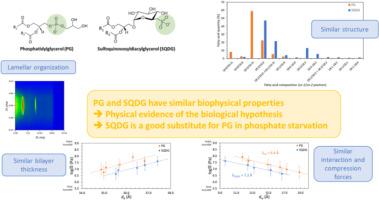Biochimica et Biophysica Acta (BBA) - Biomembranes ( IF 2.8 ) Pub Date : 2022-08-27 , DOI: 10.1016/j.bbamem.2022.184037 Stéphanie Bolik 1 , Catherine Albrieux 2 , Emanuel Schneck 3 , Bruno Demé 4 , Juliette Jouhet 2

|
From cyanobacteria to higher plants, photosynthetic membranes are composed of two galactolipids, mono- and digalactosyldiacylglycerol (MGDG and DGDG, respectively), and two negatively charged lipids, sulfoquinovosyldiacylglycerol (SQDG) and phosphatidylglycerol (PG). In many environments, plants and algae grow in a shortage of nutrients, leading to the development of nutrient-saving mechanisms. For example, at the cellular level, in phosphate starvation, these mechanisms include conversion of phospholipids into phosphorus-free lipids. In photosynthetic membranes, PG is supposed to be replaced by SQDG in phosphate starvation whereas the opposite occurs in sulfur deprivation. All biological data confirm a complementary relationship between SQDG and PG and suggest the importance of maintaining the total amount of anionic lipids in photosynthetic membranes. Using neutron diffraction on reconstituted SQDG or PG lipid membranes, we demonstrate that, despite chemically different headgroups, PG and SQDG have similar physicochemical properties. With an equivalent diacylglycerol backbone, PG and SQDG membranes have a similar bilayer thickness and bending rigidity. They also have essentially the same response to hydration in terms of repulsion and interaction forces. The results presented here establish that SQDG and PG are good substitutes to each other in nutrient starvation conditions to maintain the chloroplast functional organization and its photosynthesis activity.
中文翻译:

Sulfoquinovosyldiacylglycerol 和 phosphatidylglycerol 双层具有共同的生物物理特性,是光合膜中良好的相互替代物
从蓝细菌到高等植物,光合膜由两种半乳糖脂组成,单和双半乳糖基二酰基甘油(分别为 MGDG 和 DGDG),以及两种带负电荷的脂质,磺基喹诺基二酰基甘油 (SQDG) 和磷脂酰甘油 (PG)。在许多环境中,植物和藻类在营养缺乏的情况下生长,从而导致了营养节约机制的发展。例如,在细胞水平上,在磷酸盐饥饿中,这些机制包括将磷脂转化为无磷脂质。在光合膜中,PG 在磷酸盐饥饿中被 SQDG 取代,而在硫剥夺中则相反。所有生物学数据都证实了 SQDG 和 PG 之间的互补关系,并表明维持光合膜中阴离子脂质总量的重要性。在重组的 SQDG 或 PG 脂质膜上使用中子衍射,我们证明,尽管头基在化学上不同,但 PG 和 SQDG 具有相似的物理化学性质。PG 和 SQDG 膜具有等效的二酰基甘油骨架,具有相似的双层厚度和弯曲刚度。就排斥力和相互作用力而言,它们对水合作用的反应也基本相同。这里提供的结果表明,SQDG 和 PG 在营养缺乏条件下是很好的替代品,可维持叶绿体功能组织及其光合作用活性。在重组的 SQDG 或 PG 脂质膜上使用中子衍射,我们证明,尽管头基在化学上不同,但 PG 和 SQDG 具有相似的物理化学性质。PG 和 SQDG 膜具有等效的二酰基甘油骨架,具有相似的双层厚度和弯曲刚度。就排斥力和相互作用力而言,它们对水合作用的反应也基本相同。这里提供的结果表明,SQDG 和 PG 在营养缺乏条件下是很好的替代品,可维持叶绿体功能组织及其光合作用活性。在重组的 SQDG 或 PG 脂质膜上使用中子衍射,我们证明,尽管头基在化学上不同,但 PG 和 SQDG 具有相似的物理化学性质。PG 和 SQDG 膜具有等效的二酰基甘油骨架,具有相似的双层厚度和弯曲刚度。就排斥力和相互作用力而言,它们对水合作用的反应也基本相同。这里提供的结果表明,SQDG 和 PG 在营养缺乏条件下是很好的替代品,可维持叶绿体功能组织及其光合作用活性。PG 和 SQDG 膜具有相似的双层厚度和弯曲刚度。就排斥力和相互作用力而言,它们对水合作用的反应也基本相同。这里提供的结果表明,SQDG 和 PG 在营养缺乏条件下是很好的替代品,可维持叶绿体功能组织及其光合作用活性。PG 和 SQDG 膜具有相似的双层厚度和弯曲刚度。就排斥力和相互作用力而言,它们对水合作用的反应也基本相同。这里提供的结果表明,SQDG 和 PG 在营养缺乏条件下是很好的替代品,可维持叶绿体功能组织及其光合作用活性。































 京公网安备 11010802027423号
京公网安备 11010802027423号